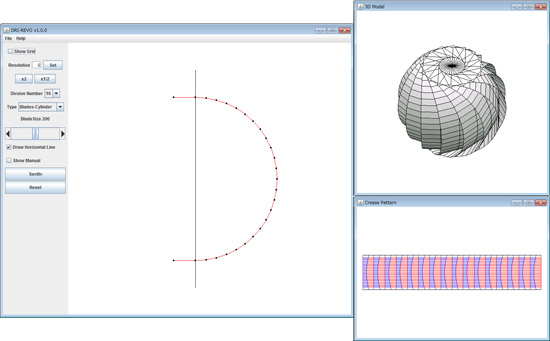ORI-REVO: A Design Tool for 3D Origami of Revolution
回転体ベースの立体折紙設計ツール
2011 Jun Mitani, Univ. of Tsukuba

The latest version is Ver.1.0.1.
Contents (目次)
Updates (更新情報)
[2011/6/3] Ver1.0.1 was released.
[2011/3/8] Importing point-list (点列データの読み込み) section was added.
[2011/3/6] This webpage was opened. (Webページ開設)
[2011/3/8] Importing point-list (点列データの読み込み) section was added.
[2011/3/6] This webpage was opened. (Webページ開設)
Introduction (はじめに)

Today, origami is popular all over the world as a universal play activity involving folding a sheet of paper. There are a lot of traditional foldings descended from forerunners. On the other hand, origami has been a target of mathematical researchers. As the result, now we have the knowledge to design such complicated origami works that we could not a few decades ago. You will find a lot of techniques about folding in recent books such as "Erik D. Demaine and Joseph O'Rourke, Geometric Folding Algorithms: Linkages, Origami, Polyhedra, Cambridge University Press" and "Robert J. Lang, Origami Design Secrets, A K Peters/CRC Press". As computers become popular, some software for designing origami has been developed (Please refer [Links] section). Techniques for making new figures by folding a single sheet of paper have been explored by many origamists even now.
I was so impressed by the art of folding techniques developed by forerunners that I stepped out into the world of origami. The software ORI-REVO presented here was developed for the purpose of exploring new origami figures by using a computer. The shapes generated with ORI-REVO are based on the surface of revolution. Not only shapes similar to packages for cakes we sometimes see, but also shapes which have curved surfaces are designed with this software. The shapes include that of several artworks known as Chris K. Palmer’s PolyPouches, Jeannine Mosely’s Bud, and Robert J. Lang’s Rimpot which are published ahead of my development. I would like to show my respect for these pioneers. Geometrically artistic figures will be rediscover and newly-discover through trials.
The above photos are some of examples designed with this tool. You can see other beautiful examples on the author's Flickr.
You can use ORI-REVO freely for non-commercial personal purposes.
折紙は1枚の紙があれば誰でも楽しめる手軽な遊戯として、世界中で親しまれています。折紙には古くから伝わる伝承的な折り方が数多くある一方で、近年では数学的な側面からの研究が盛んに行われるようになってきています。その結果として、数十年前には見られなかった複雑な作品が作られるようになってきました。折りの数理に関しては、「幾何的な折りアルゴリズム -リンケージ・折り紙・多面体(エリック・D. ドメイン, ジョセフ・オルーク著, 上原隆平訳,近代科学社)」、「Origami Design Secrets (Robert J. Lang著,A K Peters/CRC Press)」などに、近年の研究の成果をみることができます。
特に最近ではコンピュータの普及に伴い、折紙の設計を行うためのソフトウェアもいくつか登場しています(末尾の「関連ページへのリンク」を参照ください)。 現在においても、多くの折紙愛好家の手によって、1枚の紙で形を作るための新しい方法の探求が行われています。
私自身も、先人の方々の手によって編みだされた技術の巧妙さに感銘を受け、折紙の世界に足を踏み入れることになりました。ここで公開しているソフトウェアは、コンピュータを使うからこそ実現可能な、新しい形を作りだすことを目的に開発されたものです。作りだされる形は回転体をベースとした形に限定されます。
この形は、既存の菓子箱に見られる形や、PolyPouchesと名付けられたChris K. Palmer氏の作品群、Jeannine Mosely氏のOrigami Bud、Robert J. Lang氏のRimpotなど、過去に発表された多くの作品の形を包含します。これまでに新しい形を発見されてきた、このような先駆者の方々に敬意を払います。本ソフトウェアを使った試行錯誤を通して、幾何的な美しい形の再発見、および新発見ができることでしょう。
上の写真は、このアプリケーションを使って設計した作品の例です。 これら以外の作品を多数Flickrのページで公開しています。
ORI-REVO は立体的な折紙の設計支援ツールです。
非営利目的の個人使用の範囲で、自由にお使いいただけます。
License (使用条件)
You can use this application for personal purposes only.
Use in commercial projects and redistribution are not allowed without author's permission.
The author will not bear any responsibility for any loss or risk resulting from this application.
This application uses JOGL1.1 library for displaying a 3D model. Please refer LISENSE-JOGL-1.1.1.txt (included in the downloaded file) about the license of JOGL.
Please feel free to contact to: mitani (at) cs.tsukuba.ac.jp
本アプリケーションは個人使用に限定します。
作者の許可を得ずに、再配布、および商用目的での使用はできません。
本アプリケーションを使用することによって生じたいかなる損害についても作者は責任を負いません。
本アプリケーションは、3Dモデル表示にJOGL1.1ライブラリを使用しています。JOGLの使用許諾については、ダウンロードしたファイルに含まれるLISENSE-JOGL-1.1.1.txtを参照してください。
不明な点は mitani (at) cs.tsukuba.ac.jp 宛てにお問い合わせください。
Use in commercial projects and redistribution are not allowed without author's permission.
The author will not bear any responsibility for any loss or risk resulting from this application.
This application uses JOGL1.1 library for displaying a 3D model. Please refer LISENSE-JOGL-1.1.1.txt (included in the downloaded file) about the license of JOGL.
Please feel free to contact to: mitani (at) cs.tsukuba.ac.jp
本アプリケーションは個人使用に限定します。
作者の許可を得ずに、再配布、および商用目的での使用はできません。
本アプリケーションを使用することによって生じたいかなる損害についても作者は責任を負いません。
本アプリケーションは、3Dモデル表示にJOGL1.1ライブラリを使用しています。JOGLの使用許諾については、ダウンロードしたファイルに含まれるLISENSE-JOGL-1.1.1.txtを参照してください。
不明な点は mitani (at) cs.tsukuba.ac.jp 宛てにお問い合わせください。
Install and Start Up (インストールと起動)
Windows
There is no installer. Download a zip file through the following link. Then unzip the file.
ORI-REVO starts by double-clicking startup.bat file.
インストーラはありません。下のリンクからzipファイルをダウンロード後、任意のフォルダで解凍してください。解凍後に含まれる ori-revo-v101.jar をダブルクリックして起動できます。(うまくいかない場合は startup.bat ファイルをダブルクリック)
ORI-REVO Ver.1.0.1 for Windows (32bit): ori-revo-v101-win-32bit.zip
ORI-REVO Ver.1.0.1 for Windows (64bit): ori-revo-v101-win-64bit.zip
(old version) ORI-REVO Ver.1.0.0 for Windows : ori-revo-v100-win.zip
起動しない場合は、Javaの実行環境がインストールされていない可能性があります(コマンドプロンプトで java -version と入力して確認できます)。ORI-REVOを起動する前にJavaをインストールしてください。
※ 研究用に開発したソフトウェアであり、動作保証はしておりません。申し訳ありませんが、起動方法や動作のトラブルに関する個別の問い合わせには回答できません。
ORI-REVO starts by double-clicking startup.bat file.
インストーラはありません。下のリンクからzipファイルをダウンロード後、任意のフォルダで解凍してください。解凍後に含まれる ori-revo-v101.jar をダブルクリックして起動できます。(うまくいかない場合は startup.bat ファイルをダブルクリック)
ORI-REVO Ver.1.0.1 for Windows (32bit): ori-revo-v101-win-32bit.zip
ORI-REVO Ver.1.0.1 for Windows (64bit): ori-revo-v101-win-64bit.zip
(old version) ORI-REVO Ver.1.0.0 for Windows : ori-revo-v100-win.zip
起動しない場合は、Javaの実行環境がインストールされていない可能性があります(コマンドプロンプトで java -version と入力して確認できます)。ORI-REVOを起動する前にJavaをインストールしてください。
※ 研究用に開発したソフトウェアであり、動作保証はしておりません。申し訳ありませんが、起動方法や動作のトラブルに関する個別の問い合わせには回答できません。
Mac OS
Download a zip file through the following link. Then unzip the file.
ORI-REVO starts by double-clicking ori-revo-v101.jar file.
下のリンクからzipファイルをダウンロード後、任意のディレクトリで解凍してください。解凍後に含まれる ori-revo-v101.jar をダブルクリックするだけで起動します。
ORI-REVO Ver.1.0.1 for MacOSX : ori-revo-v101-mac.zip
(old version) ORI-REVO Ver.1.0.1 for MacOSX : ori-revo-v100-mac.zip
ORI-REVO starts by double-clicking ori-revo-v101.jar file.
下のリンクからzipファイルをダウンロード後、任意のディレクトリで解凍してください。解凍後に含まれる ori-revo-v101.jar をダブルクリックするだけで起動します。
ORI-REVO Ver.1.0.1 for MacOSX : ori-revo-v101-mac.zip
(old version) ORI-REVO Ver.1.0.1 for MacOSX : ori-revo-v100-mac.zip
Update History
[Ver1.0.1]
- Undo feature was added.
- Known bugs were fixed.
- It became possible to specify the finished size.
[Ver1.0.0]
- First release.
- Undo feature was added.
- Known bugs were fixed.
- It became possible to specify the finished size.
[Ver1.0.0]
- First release.
Usage (使用方法)

The usage of ORI-REVO is simple.
The main operation is just inputting a polyline on the main window by left click. 3D model and the crease pattern are updated in real-time.
The crease pattern is exported to a DXF file (a vector file compatible with Adobe Illustrator) or a PNG file (a raster image) through [File] menu.
[Show Manual] check box displays instructions for editing the input 2D polyline.
The effects of other parameters on the control panel are reflected to the 3D model and the crease pattern immediately. Please try to change parameters. You will soon find the purposes of them.
Some sample data as shown in the above image are included in the sample folder.
ORI-REVO の使い方はとても簡単です。
主な操作は、メイン画面でマウスをクリックして、折り線を入力するだけです。 3Dモデルと展開図がリアルタイムで更新されます。
展開図は、Adobe Illustratorで読み込むことができるDXF形式、またはPNG画像の形式で保存できます。
入力した折り線の編集方法は[Show Manual]チェックボックスをチェックすると表示されます。
コントロールパネル上の他のパラメータは、変更と同時に3Dモデルと展開図に反映されるので、いろいろ試してみてください。
sampleフォルダには上記のイメージのサンプルが含まれています。
Importing point-list (点列データの読み込み)
ORI-REVO can import point-list data from an external text file.
The x and y coordinates of points should be listed sequentially in the file as this example (example.polyline).
The extension should be .polyline.
It is preferable that the points are in (-200, -200)-(200,200) square area.
ORI-REVOは、外部ファイルからテキスト形式で記述された点列情報を読み込むことができます。読み込むことができるファイルは、こちらのサンプル(example.polyline)のように、各点のx座標値とy座標値が列挙されている必要があります。また、ファイルの拡張子は.polylineである必要があります。各点は、(-200, -200)-(200,200)の正方形に収まるようにします。
The x and y coordinates of points should be listed sequentially in the file as this example (example.polyline).
The extension should be .polyline.
It is preferable that the points are in (-200, -200)-(200,200) square area.
ORI-REVOは、外部ファイルからテキスト形式で記述された点列情報を読み込むことができます。読み込むことができるファイルは、こちらのサンプル(example.polyline)のように、各点のx座標値とy座標値が列挙されている必要があります。また、ファイルの拡張子は.polylineである必要があります。各点は、(-200, -200)-(200,200)の正方形に収まるようにします。
Making movie (制作風景)
Books published in Japan (書籍)
- 三谷 純 (著) "立体ふしぎ折り紙", 二見書房, ISBN 9784576101736, 2010/12
- 三谷 純 (著) "ふしぎな 球体・立体 折り紙", 二見書房, ISBN 4576091611, 2009/11
Links (関連ページへのリンク)
- The author's page (作者のWebページ)
- List of origami related applications (折紙関係ソフトの一覧)
- Documents (関連資料)
- Computational origami tools (折紙設計用ソフトウェア)
- - Tree Maker (by Robert J. Lang)
- - Origami Flanged Pots (by Robert J. Lang)
- - Tess (by Alex Bateman)
- - Rigid Origami Simulator (by Tomohiro Tachi)
- - Origamizer (by Tomohiro Tachi)
- - Freeform Origami (by Tomohiro Tachi)
- - ORIPA (by Jun Mitani)
- * Please let me know other computational origami tools that should be listed in here.
- Others (その他)
Contact (問い合わせ)
Jun Mitani, University of Tsukuba, Department of Computer Science
三谷 純, 筑波大学システム情報工学研究科コンピュータサイエンス専攻
mitani [at] cs.tsukuba.ac.jp
三谷 純, 筑波大学システム情報工学研究科コンピュータサイエンス専攻
mitani [at] cs.tsukuba.ac.jp



